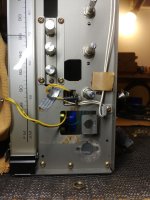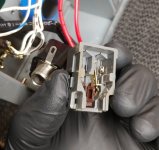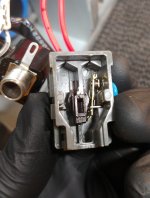Hello everyone,
a couple years ago my AKAI AA-1020 got recapped and serviced, and it ran great considering its age. Never could I get rid of the slightest hum, and a pop when switching to/from the radio on the input selector, though I could’ve lived with that. It also makes the infamous power-on thump. (maybe a hint?)
Recently the unit's been developing a heat issue, where the area around the power switch/headphone input/speaker selector on the faceplate gets rather warm - the speaker knob weirdly gets the warmest. After spending an entire day inspecting the power supply/output boards and adjust idling current, the issue was no longer present. Since this morning, however, said area is warming up again, giving me reason for concern. No other issues have developed, the sound is still clear and powerful.
Where should I be starting to look for such a fault? Would the (dirty) power switch come to suspicion?
a couple years ago my AKAI AA-1020 got recapped and serviced, and it ran great considering its age. Never could I get rid of the slightest hum, and a pop when switching to/from the radio on the input selector, though I could’ve lived with that. It also makes the infamous power-on thump. (maybe a hint?)
Recently the unit's been developing a heat issue, where the area around the power switch/headphone input/speaker selector on the faceplate gets rather warm - the speaker knob weirdly gets the warmest. After spending an entire day inspecting the power supply/output boards and adjust idling current, the issue was no longer present. Since this morning, however, said area is warming up again, giving me reason for concern. No other issues have developed, the sound is still clear and powerful.
Where should I be starting to look for such a fault? Would the (dirty) power switch come to suspicion?
Hi taperrrick87,
Heat = power loss. Are the headphone jack dropping resistors heating up? Otherwise switch contacts under high load could heat up, but they would be burning and your sound wouldn't be clear.
It could be oscillating, look also for intermittent ground connections and mechanical things you wouldn't normally consider.
Heat = power loss. Are the headphone jack dropping resistors heating up? Otherwise switch contacts under high load could heat up, but they would be burning and your sound wouldn't be clear.
It could be oscillating, look also for intermittent ground connections and mechanical things you wouldn't normally consider.
Does it warm up also when not playing anything, in idling state?
Does it warm up when "playing" (i.e. volume knob n regular listening position) but with speakers disconnected?
If it is oscillating then it could be observed with a scope?
Regarding power on thump - it does not have any speaker protection relay so the only way to avoid it would be to disconnect the speakers (via the selector switch) during powerup and poweroff.

Does it warm up when "playing" (i.e. volume knob n regular listening position) but with speakers disconnected?
If it is oscillating then it could be observed with a scope?
Regarding power on thump - it does not have any speaker protection relay so the only way to avoid it would be to disconnect the speakers (via the selector switch) during powerup and poweroff.
No, you can't disconnect the speakers. The output cap has to charge, it may make a worse bang in the speakers if you delay that. Best to just leave it alone.
Wouldn't a 10k (for example) resistor to ground (from e.g. terminal 11) take care of that?it may make a worse bang in the speakers if you delay that.
Actually I missed the fact that the grounding resistor is missing.
Do you mean charging the 3300uF C9?Figure out the time constant and that is how long it takes (x 5).
I sort of fail to understand - the right side is and continues to be on ground potential (DC wise) during powerup, the left side gets its DC voltage via the output transistors?
The 3,300 uF 35 V capacitor (C9) is the output coupling capacitor.
Yes, the positive side charges up to just over 1/2 B+. The other side charges through the load (speaker).
Yes, the positive side charges up to just over 1/2 B+. The other side charges through the load (speaker).
Without any AC signal it should remain on ground DC level?The other side charges through the load (speaker).
No, it charges to a level when the circuit is powered up. It stays at that average DC level. So until it charges, the speaker has to pass the charging current.
Oh, you mean the initial state, without the bleeding (e.g. 10k) resistor?No, it charges to a level when the circuit is powered up. It stays at that average DC level.
From above.Yes it would. Figure out the time constant and that is how long it takes (x 5).
After spending an entire day inspecting the power supply/output boards and adjust idling current, the issue was no longer present.
Which way did you adjust the current, up or down? Make sure you follow any specific procedure given and when all is said and done make sure the current is not higher than normal after playing the amp loud and getting it really hot. Err on the low side if anything.
Pictures of the front panel show a meter in that area in addition to the tuner scale. Incandescent bulbs getting hot?Recently the unit's been developing a heat issue, where the area around the power switch/headphone input/speaker selector on the faceplate gets rather warm
Very doubtful imo. If it was arcing and so on you would likely hear it both physically and also as interference.Would the (dirty) power switch come to suspicion?
If you suspect the switch then make sure the mains plug is disconnected and just feel it.
Got to admit, never thought I would actually get a response let alone this many - thank you for taking interest in my repair!
Quick question while I got the power switch apart: Does it benefit from adding a small amount of dielectric grease on the contacts, i.e. regular superlube grease? I've read conflicting things online and don't intend to make things worse. (It only had a small amount of carbon built up in it)
The issue has become more complicated as it happens intermittently. On the same outlet, the unit turned from fine one afternoon to warm the next day. Later on another outlet, it ran fine for a couple of hours. This morning it warmed up again. I believe it also fluctuates in temperature... IIRC during longer sessions under load, when I noticed the amp getting warm the first time, I seem to remember even the heat vents/output board to have gotten warm. But now it was warming up with speakers disconnected or just on headphones, volume off and mid, and intermittently after running for a couple of hours.
I suspected it might be the light bulb for the signal strength as well for a while, however the areas around the other two bulbs do not get (as) warm. I don't think it would warm up enough for the heat to extend further left to the power switch, being located right above the speaker selector.
Once I get the unit assembled again, I’ll get to comparing idling current readings between normal/‘warmed up’ and stressed/after playing music loudly for a while. Unfortunately I couldn’t reliably say whether it had crept up before this recent servicing; I think I adjusted it too soon for that.
Just so I’m doing this absolutely right (the service manual is not exactly accurate): Speakers should generally be disconnected and volume at 0 for this adjustment, right?
(A digital oscilloscope would be available as well, however I’m only a novice with that as well, having used it only for calibrating tape decks so far.)
Quick question while I got the power switch apart: Does it benefit from adding a small amount of dielectric grease on the contacts, i.e. regular superlube grease? I've read conflicting things online and don't intend to make things worse. (It only had a small amount of carbon built up in it)
The issue has become more complicated as it happens intermittently. On the same outlet, the unit turned from fine one afternoon to warm the next day. Later on another outlet, it ran fine for a couple of hours. This morning it warmed up again. I believe it also fluctuates in temperature... IIRC during longer sessions under load, when I noticed the amp getting warm the first time, I seem to remember even the heat vents/output board to have gotten warm. But now it was warming up with speakers disconnected or just on headphones, volume off and mid, and intermittently after running for a couple of hours.
I suspected it might be the light bulb for the signal strength as well for a while, however the areas around the other two bulbs do not get (as) warm. I don't think it would warm up enough for the heat to extend further left to the power switch, being located right above the speaker selector.
Once I get the unit assembled again, I’ll get to comparing idling current readings between normal/‘warmed up’ and stressed/after playing music loudly for a while. Unfortunately I couldn’t reliably say whether it had crept up before this recent servicing; I think I adjusted it too soon for that.
Just so I’m doing this absolutely right (the service manual is not exactly accurate): Speakers should generally be disconnected and volume at 0 for this adjustment, right?
(A digital oscilloscope would be available as well, however I’m only a novice with that as well, having used it only for calibrating tape decks so far.)
Before doing that you could take and post some photos of the switch area.Once I get the unit assembled again,
What kind of scope would that be? The modern ones usually have an autoset button which will do most of the hardwork for you (in the beginning).
Just so I’m doing this absolutely right (the service manual is not exactly accurate): Speakers should generally be disconnected and volume at 0 for this adjustment, right?
As this is an AC coupled amp it does matter whether speakers are connected or not. Volume setting as such also has no effect but there should be no actual music playing.
Quick question while I got the power switch apart: Does it benefit from adding a small amount of dielectric grease on the contacts, i.e. regular superlube grease? I've read conflicting things online and don't intend to make things worse. (It only had a small amount of carbon built up in it)
The grease used in switches is often called montage grease:
https://electrolube.com/app/uploads/2019/09/SPGA.pdf
I wouldn't like to suggest what if anything else you could/should use. Mains switches generally are either OK or not and if there is doubt then we always replace them. I still seriously doubt there is a switch problem although if you have actually opened it up... 😱 then all things are possible. Mains switches just don't tend to survive once they start having real issues. Heat usually means arcing and that destroys the switch very quickly.
If you link the switch out you conclusively eliminate it from your enquiries, just make sure you link the contacts out and not inadvertently apply a short across the mains.
@madis64
The scope is a Hanmatek DOS1102
@Mooly
In earlier attempt to combat the power-on thump, cleaning of the main switch helped for a short while. When it returned I followed instructions on installing new contacts as the old pads were too worn down. Needless to say the thump has returned and it’s been arcing again. This error pattern made me consider exterior causes, apparently proven by the latest overheating issue.
For this model switch there seemingly was no suitable replacement available at the time, certainly no NOS-parts/just cheap clones.
Working on the switch, I also noticed a crack on the housing of the headphone input, however I doubt it would have an impact like this without causing sound issues.
Thanks for the grease recommendation; I think I remember reading about it back then and it not being available for the longest time. Shipping seems to be a bit of an issue, but I’ll try to get it here timely.
Pardon my ignorance, English isn’t my first language. I am honestly a bit confused by the (double?) meaning of “linked out”… Should I bypass the switch = “hot-wire” the amp and use an external flip-switch on the outlet?
The scope is a Hanmatek DOS1102
@Mooly
In earlier attempt to combat the power-on thump, cleaning of the main switch helped for a short while. When it returned I followed instructions on installing new contacts as the old pads were too worn down. Needless to say the thump has returned and it’s been arcing again. This error pattern made me consider exterior causes, apparently proven by the latest overheating issue.
For this model switch there seemingly was no suitable replacement available at the time, certainly no NOS-parts/just cheap clones.
Working on the switch, I also noticed a crack on the housing of the headphone input, however I doubt it would have an impact like this without causing sound issues.
Thanks for the grease recommendation; I think I remember reading about it back then and it not being available for the longest time. Shipping seems to be a bit of an issue, but I’ll try to get it here timely.
Pardon my ignorance, English isn’t my first language. I am honestly a bit confused by the (double?) meaning of “linked out”… Should I bypass the switch = “hot-wire” the amp and use an external flip-switch on the outlet?
Attachments
It has Autoset button and should be pretty easy to operate on beginner level:The scope is a Hanmatek DOS1102
From the photos it seems that the bulb is quite near to the speaker selector knob axis so if it sometimes warms up and sometimes does not then I would be curious about the times when it does not warm up.
And the bulb location seems a bit strange - are you sure it has not been misplaced in some way during earlier repairs?
From what I can see that switch looks fine and the contacts look really good. Any switching of an inductive load like a big transformer will generate an arc of some sort and it is normal to see 'deterioration' of contacts but that in itself is not really an issue. It looks better than most tbh.
Now you might find it seems 'worse' depending on where the volume is set and what input is selected and so on simply because there are more caps in the rest of the circuit that also have to charge and so you hear those (as they feed into the input of the power amp) as well as the speaker cap charging. If you turn the volume down you hear just the speaker cap charge.
Looking at your picture it seems only those two red wires go to the switch and so the switch is a single pole type. If that is so then just tag a wire across the switch terminals to short the two red wires together and turn the amp on and off via the plug or wall switch. Use it a while like that and see if it seems better or not.
Switch on thump is normal in any AC coupled amp and occurs because the big speaker coupling capacitor has to charge up and the only path for it do that is via the speaker.In earlier attempt to combat the power-on thump, cleaning of the main switch helped for a short while.
Now you might find it seems 'worse' depending on where the volume is set and what input is selected and so on simply because there are more caps in the rest of the circuit that also have to charge and so you hear those (as they feed into the input of the power amp) as well as the speaker cap charging. If you turn the volume down you hear just the speaker cap charge.
As you say 🙂 hot wire it.I am honestly a bit confused by the (double?) meaning of “linked out”… Should I bypass the switch = “hot-wire” the amp and use an external flip-switch on the outlet?
Looking at your picture it seems only those two red wires go to the switch and so the switch is a single pole type. If that is so then just tag a wire across the switch terminals to short the two red wires together and turn the amp on and off via the plug or wall switch. Use it a while like that and see if it seems better or not.
- Home
- Amplifiers
- Solid State
- AKAI AA-1020 heat issue on faceplate


